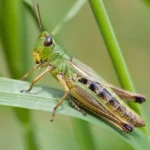
The common yabby (Cherax destructor) is a fascinating freshwater crustacean native to Australia, known for its adaptability and resilience. With a potential to grow up to 30 centimeters in length and a life span of 5 to 7 years, these creatures exhibit a range of colors from black and blue to brown, depending on their environment. They play a significant role in their ecosystems as omnivores and are also valued for their use in aquaculture. Yabbies can survive in various water conditions and are capable of burrowing into the mud to withstand dry periods, showcasing their remarkable survival strategies.
- Native Habitat: The common yabby, Cherax destructor, is indigenous to Australia, thriving in freshwater ecosystems such as rivers, lakes, and ponds. This species is remarkably adaptable, capable of inhabiting a range of aquatic environments, from clear, fast-flowing streams to turbid, slow-moving waters. Its presence is widespread across the Australian continent, with the exception of the northern tropics, Tasmania, and the southwest of Western Australia. The yabby’s ability to burrow and estivate allows it to survive in regions with variable climates and water availability.
- Color Variations: Common yabbies exhibit a fascinating array of colors that can be influenced by environmental factors such as water quality, diet, and the presence of certain minerals. While their typical coloration ranges from dark brown to olive green, some populations display striking blue and black hues. Rarely, individuals may even appear translucent or nearly white. These color variations do not denote different species but rather phenotypic plasticity within the species, allowing yabbies to blend into their surroundings and evade predators.
- Size and Growth: On average, common yabbies grow to a length of 10 to 20 centimeters (4 to 8 inches), but under ideal conditions, they can achieve a maximum size of 30 centimeters (12 inches). Their growth rate is influenced by factors such as food availability, water temperature, and population density. Larger individuals are often dominant within their habitats and can be more successful in competing for resources and mates.
- Lifespan: In the wild, common yabbies typically live for 5 to 7 years, although their lifespan can be influenced by environmental conditions and predation pressures. Yabbies reach sexual maturity within their first year of life, which allows for rapid population growth and recovery, even after significant environmental disturbances.
- Estivation: During periods of drought or when water levels drop, common yabbies can burrow deep into the mud and enter a state of estivation. This physiological adaptation involves slowing their metabolic rate to conserve energy and survive for months without food or water. This remarkable survival strategy allows yabbies to endure the harsh and unpredictable Australian climate.
- Land Migration: Common yabbies are not solely confined to aquatic environments; they are also capable of undertaking overland migrations to seek out new habitats. These migrations typically occur during wet conditions, such as after heavy rains, when yabbies can move across damp soil. This behavior enables them to colonize new water bodies and maintain genetic diversity among populations.
- Diet: As omnivores, common yabbies have a diverse diet that includes both plant material and animal matter. They feed on a variety of food sources such as algae, detritus, macrophytes, insects, and small fish. This opportunistic feeding behavior allows yabbies to thrive in a wide range of conditions and contributes to their role as important recyclers of organic matter within their ecosystems.
- Maximum Weight: Common yabbies can reach substantial sizes, with some individuals weighing up to 600 grams (1.32 pounds). Such large specimens are often found in environments with abundant food sources and minimal competition. Their size not only affects their position within the social hierarchy but also their appeal in the culinary market, where larger yabbies are highly valued.
- Breeding Season: The breeding season for common yabbies typically occurs during the warmer months, from October to March. During this time, females can produce multiple clutches of eggs, with each clutch containing up to 1,000 eggs. The eggs are carried beneath the female’s tail until they hatch, providing protection and aeration to ensure successful development.
- Commercial Significance: Common yabbies are not only ecologically important but also have significant commercial value. They are harvested for both the aquarium trade and as a food source. In the culinary world, yabbies are considered a delicacy and are often compared to lobsters in terms of taste and texture. The commercial farming of yabbies, known as yabby aquaculture, has become an important industry in Australia, with strict regulations in place to ensure sustainable practices.
- Burrowing Behavior: Common yabbies are known for their ability to burrow into the ground to escape harsh environmental conditions. During dry spells, they can dig down several meters to reach moisture, creating a chamber where they can remain dormant for months. This survival strategy is crucial in their native Australian habitats, which can be subject to extreme fluctuations in water availability. The burrows not only provide refuge from desiccation but also from temperature extremes and predators.
- Overland Migration: Remarkably, common yabbies are not confined to their aquatic habitats. They can embark on overland treks during the night or after rain to find new water bodies. This ability to traverse land allows them to colonize new habitats and avoid areas that have dried up. During these migrations, yabbies can cover significant distances, which is a testament to their adaptability and resilience.
- Dietary Habits: Common yabbies are opportunistic omnivores, consuming a wide range of food sources. Their diet includes algae, plant material, carrion, and small aquatic animals. They play a vital role in the ecosystem by helping to break down dead organic matter and controlling the populations of other small aquatic organisms. Their feeding habits also contribute to the cycling of nutrients within their freshwater habitats.
- Growth and Size: Yabbies can reach a maximum length of 30 centimeters (12 inches), making them one of the larger freshwater crustaceans in their environment. However, most individuals are found to be between 10 to 20 centimeters (4 to 8 inches) in length. Their growth rate is influenced by factors such as water temperature, food availability, and population density. Yabbies continue to grow throughout their lives, molting their exoskeleton to accommodate their increasing size.
- Lifespan: In the wild, common yabbies typically live for about 5 to 7 years, although this can vary depending on environmental conditions and predation pressures. Their lifespan is also influenced by the availability of food and the quality of their aquatic habitat. In captivity, with optimal conditions, yabbies may live longer due to the absence of predators and controlled environments.
- Estivation: During periods of drought or when water temperatures become too high, common yabbies can enter a state of estivation. This is a form of dormancy where they reduce their metabolic rate to conserve energy. While estivating, yabbies seal themselves in their burrows with a mud plug to maintain humidity and protect themselves from predators and the elements.
- Reproductive Cycle: Common yabbies have a reproductive cycle that is influenced by water temperature and can vary geographically. They typically breed in warmer months, and females can produce several hundred eggs per clutch. The eggs are carried under the female’s tail until they hatch into free-swimming larvae, which then undergo several molts before reaching juvenile stage.
- Aquaculture: The common yabby is not only an important part of the ecosystem but also has significance in aquaculture. They are farmed for food, with their meat being a delicacy in some regions. Yabby farming has become an industry in Australia, with specific breeding programs designed to enhance growth rates and disease resistance for commercial production.
- Predators and Threats: Yabbies face predation from a variety of animals, including fish, birds, and mammals. Human activities, such as habitat destruction, pollution, and the introduction of invasive species, also pose significant threats to yabby populations. Conservation efforts are important to ensure the sustainability of their populations in the wild.
- Ecosystem Engineers: Common yabbies are considered ecosystem engineers due to their burrowing activities, which can alter the physical characteristics of their habitats. Their burrows can affect water flow and sediment composition, creating microhabitats that benefit other species. By modifying their environment, yabbies contribute to the biodiversity and functioning of freshwater ecosystems.
- Reproductive Capacity: Common yabbies are prolific breeders, with females capable of producing up to 1,000 eggs per breeding cycle. These eggs are carried under the tail until they hatch into free-swimming larvae. The breeding season for yabbies typically occurs in the warmer months, from October to March, which aligns with the Southern Hemisphere’s spring and summer seasons.
- Aquaculture: The common yabby is not only a popular species in the wild but also in aquaculture. They are farmed for their meat and are considered a delicacy in some parts of the world. Yabby farming has become an important industry in Australia, with farms designed to optimize conditions for yabby growth and reproduction. The industry has developed selective breeding programs to enhance desirable traits such as size, growth rate, and color.
- Escape Artists: Yabbies have a remarkable ability to escape from captivity. They are known to climb out of tanks or ponds if the conditions are not to their liking or if they sense an opportunity to explore new environments. This behavior underscores the importance of secure containment in both aquaculture and home aquarium settings to prevent escape.
- Environmental Indicators: Common yabbies are considered bioindicators of environmental quality. Their presence and health can reflect the state of their aquatic ecosystem. A decline in yabby populations can signal environmental issues such as pollution, habitat destruction, or changes in water parameters, prompting conservationists and scientists to investigate and address potential ecological problems.
- Cultural Significance: The common yabby holds cultural significance for some Indigenous Australian communities, who have traditionally harvested yabbies for food. The methods of catching yabbies, such as using woven traps, are part of the cultural heritage and demonstrate the sustainable use of natural resources by Indigenous peoples. The yabby is not only an important ecological component of Australian freshwater systems but also a species with historical and ongoing cultural value.
FAQs about Common Yabbies:
- What is the common yabby and where can it be found?
The common yabby (Cherax destructor) is a freshwater crustacean native to southeastern Australia. It inhabits rivers, streams, lakes, and ponds, and is particularly adept at surviving in a wide range of environmental conditions, including areas with temporary water bodies. Yabbies are known for their ability to burrow into the mud to escape drying conditions. - How big do common yabbies grow, and what is their lifespan?
Common yabbies can reach a maximum length of about 30 centimeters (12 inches), although the average size is typically between 10 to 20 centimeters (4 to 8 inches). Their lifespan in the wild ranges from 5 to 7 years, depending on environmental factors and predation pressures. - What do common yabbies eat, and what is their role in the ecosystem?
As omnivores, common yabbies have a diverse diet that includes plant material, detritus, and small aquatic animals. They play a crucial role in the ecosystem by contributing to the breakdown of organic matter and serving as prey for a variety of fish, birds, and other wildlife. - Can common yabbies be kept in home aquariums?
Yes, common yabbies can be kept in home aquariums, but they require specific conditions to thrive. They need a tank with plenty of hiding places and a substrate suitable for burrowing. The water should be well-oxygenated, and the tank must have a secure lid as yabbies can climb and may attempt to escape. It’s important to research their care requirements thoroughly before deciding to keep them as pets. - Are common yabbies used in aquaculture, and can they be eaten?
Common yabbies are indeed used in aquaculture and are considered a delicacy in some regions. They are farmed for their meat and are a popular choice for freshwater crustacean farming in Australia. Yabby farming requires careful management of water quality and population density to ensure healthy and sustainable production.









